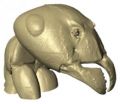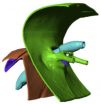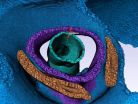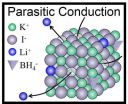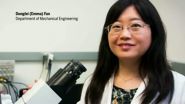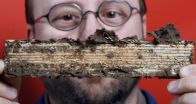(Press-News.org) A recent study into the biomechanics of the necks of ants – a common insect that can amazingly lift objects many times heavier than its own body – might unlock one of nature's little mysteries and, quite possibly, open the door to advancements in robotic engineering.
A small group of engineers at The Ohio State University combined laboratory testing and computational modeling conducted at the Ohio Supercomputer Center to determine the relationship between the mechanical function, structural design and material properties of the Allegheny mound ant (Formica exsectoides). Their results were recently published in an article, "The exoskeletal structure and tensile loading behavior of an ant neck joint," in the Journal of Biomechanics.
The study focused on the ant's neck – the single joint of soft tissue that bridges the stiff exoskeleton of the ant's head and thorax. When an ant carries food or any other object, the neck joint supports the full weight of the load.
"Loads are lifted with the mouthparts, transferred through the neck joint to the thorax, and distributed over six legs and tarsi that anchor to the supporting surface," explained Carlos Castro, assistant professor of mechanical and aerospace engineering at Ohio State. "While previous research has explored attachment mechanisms of the tarsi (feet), little is known about the relation between the mechanical function and the structural design and material properties of the ant."
To better understand the strengths and upper limits of the ant's neck, the researchers reverse-engineered the biomechanics by developing 3-D models of the of the ant's internal and external anatomy. The models were created by importing X-ray cross-section images (microCT) of ant specimens into a modeling program (ScanIPþFE) that assembled the segments and converted them into a mesh frame model of more than 6.5 million elements.
The model then was loaded into a finite element analysis program (Abaqus), an application that creates accurate simulations of complex geometries and forces, and the data was processed on the powerful Oakley Cluster, an array of 8,300 processor cores (Intel Xeon) at the Ohio Supercomputer Center.
The simulations were run in conjunction with lab experiments that used a centrifuge to measure changes in the ants' anatomies under a range of calculated loads. The experiments revealed that the neck joints could withstand loads of about 5,000 times the ant's body weight, and that the ant's neck-joint structure produced the highest strength when its head was aligned straight, as opposed to turned to either side.
"Our results accurately pinpoint the stress concentration that leads to neck failure and identify the soft-to-hard material interface at the neck-to-head transition as the location of failure," said Castro. "The design and structure of this interface is critical for the performance of the neck joint. The unique interface between hard and soft materials likely strengthens the adhesion and may be a key structural design feature that enables the large load capacity of the neck joint."
The simulations confirmed the joint's directional strength and, consistent with the experimental results, indicated that the critical point for failure of the neck joint is at the neck-to-head transition, where soft membrane meets the hard exoskeleton.
"The neck joint [of the ant] is a complex and highly integrated mechanical system. Efforts to understand the structure-function relationship in this system will contribute to the understanding of the design paradigms for optimized exoskeleton mechanisms," said former Ohio State student Vienny N. Nguyen in her 2012 master's thesis on this research. Nguyen, now a robotics engineer at Johnson Space Center, earlier worked on the project under the supervision of Blaine Lilly, an associate professor of mechanical and aerospace engineering at Ohio State. Nguyen and Lilly are co-authors with Castro on the journal paper.
"As we look to the future of human-assistive devices and ultra-light robotics," she said, "the development of 3-dimensional models for visual analysis and loading and kinematic simulation will also serve as tools for evaluating and comparing the functional morphology of multiple species and types of joints."
INFORMATION:
This project was supported by funding from Ohio State's Institute for Materials Research and Nguyen's National Science Foundation graduate research fellowship.
Scientists study biomechanics behind amazing ant strength
OSU's Castro leverages OSC systems to study 3-D model of ant anatomy
2014-05-20
ELSE PRESS RELEASES FROM THIS DATE:
New lithium battery created in Japan
2014-05-20
WASHINGTON D.C., May 20, 2014 -- The long life of lithium ion batteries makes them the rechargeable of choice for everything from implantable medical devices to wearable consumer electronics. But lithium ion batteries rely on liquid chemistries involving lithium salts dissolved in organic solvents, creating flame risks that would be avoided if the cells were completely solid-state.
Now a team of researchers at Tohoku University in Japan has created a new type of lithium ion conductor for future batteries that could be the basis for a whole new generation of solid-state ...
Reading privacy policy lowers trust
2014-05-20
Website privacy policies are almost obligatory for many online services, but for anyone who reads these often unwieldy documents, trust in the provider is more commonly reduced than gained, according to US researchers.
Almost every commercial website, social network, search engine and banking site has a privacy policy. Indeed, these and countless other sites that scrape personal information via forms, logins and tracking cookies are obliged by law in some parts of the world to post a document online giving details of how they protect any personal data you give the site ...
Can mobile phones cause allergic reactions?
2014-05-20
New Rochelle, NY, May 20, 2014—Studies have identified mobile phones and related devices as sources of metal sensitization and potential causes of allergic contact dermatitis (ACD). Despite efforts to control allergen release in phones, many phones on the market release levels of metals, such as nickel and chromium, which are sufficient to induce ACD, according to an article in Pediatric Allergy, Immunology, and Pulmonology, a peer-reviewed journal published by Mary Ann Liebert, Inc., publishers. The article is available free on the Pediatric Allergy, Immunology, and Pulmonology ...
Climate change brings mostly bad news for Ohio
2014-05-20
COLUMBUS, Ohio— Scientists delivered a mostly negative forecast for how climate change will affect Ohioans during the next year or so, and well beyond.
Researchers report that the projected increase in precipitation and the associated runoff will likely lead to a larger-than-average bloom of harmful blue-green algae in Lake Erie this summer. In addition, the development of an El Niño over the Pacific later this year may result in a very dry 2015 in Ohio. But Ohio may fare better than its neighbors in one respect: While drought and high temperatures are expected to shrink ...
NIH researchers discover key factor in early auditory system development
2014-05-20
Researchers at the National Institutes of Health have uncovered a molecule in an animal model that acts as a key player in establishing the organization of the auditory system. The molecule, a protein known as Bmp7, is produced during embryonic development and acts to help sensory cells find their ultimate position on the tonotopic map, which is the fundamental principle of organization in the auditory system. The tonotopic map groups sensory cells by the sound frequencies that stimulate them. The study is the first to identify one of the molecular mechanisms that determines ...
Is there really cash in your company's trash?
2014-05-20
This news release is available in French. One company's trash can be another's treasure.
Take Marmite. Made from a by-product of commercial beer production, the yeast-based spread has topped toast throughout the Commonwealth for decades. By recuperating the waste product from one company, another was able to thrive.
Environmental concerns are at the forefront of government policy, so the time is right for companies worldwide to adopt this type of resource exchange, known as industrial symbiosis (IS).
A new study by Concordia University researcher Raymond Paquin ...
Engineers build world's smallest, fastest nanomotor
2014-05-20
VIDEO:
Cockrell School of Engineering assistant professor Donglei (Emma) Fan and her mechanical engineering team have built the fastest, smallest nanomotor to date. The team's nanomotor could enable controlled drug delivery...
Click here for more information.
Researchers at the Cockrell School of Engineering at The University of Texas at Austin have built the smallest, fastest and longest-running tiny synthetic motor to date. The team's nanomotor is an important step toward ...
Program to reduce behavior problems boosts math, reading, NYU Steinhardt study shows
2014-05-20
A program aimed at reducing behavior problems in order to boost academic achievement has improved performance in math and reading among low-income kindergartners and first graders, according to a study by researchers at New York University's Steinhardt School of Culture, Education, and Human Development.
Their findings, which appear in the Journal of Educational Psychology, point to the value of well-designed interventions to improve education, the study's authors say.
"Supporting young low-income children so they can reach their potential in the classroom and beyond ...
Professors' super waterproof surfaces cause water to bounce like a ball
2014-05-20
In a basement lab on BYU's campus, mechanical engineering professor Julie Crockett analyzes water as it bounces like a ball and rolls down a ramp.
This phenomenon occurs because Crockett and her colleague Dan Maynes have created a sloped channel that is super-hydrophobic, or a surface that is extremely difficult to wet. In layman's terms, it's the most extreme form of water proof.
Engineers like Crockett and Maynes have spent decades studying super-hydrophobic surfaces because of the plethora of real-life applications. And while some of this research has resulted in ...
Termite genome lays roadmap for 'greener' control measures
2014-05-20
WEST LAFAYETTE, Ind. - A team of international researchers has sequenced the genome of the Nevada dampwood termite, providing an inside look into the biology of the social insect and uncovering new genetic targets for pest control.
Michael Scharf, a Purdue University professor of entomology who participated in the collaborative study, said the genome could help researchers develop control strategies that are more specific than the broad-spectrum chemicals conventionally used to treat termite infestations.
"The termite genome reveals many unique genetic targets that can ...
LAST 30 PRESS RELEASES:
Tracing the quick synthesis of an industrially important catalyst
New software sheds light on cancer’s hidden genetic networks
UT Health San Antonio awarded $3 million in CPRIT grants to bolster cancer research and prevention efforts in South Texas
Third symposium spotlights global challenge of new contaminants in China’s fight against pollution
From straw to soil harmony: International team reveals how biochar supercharges carbon-smart farming
Myeloma: How AI is redrawing the map of cancer care
Manhattan E. Charurat, Ph.D., MHS invested as the Homer and Martha Gudelsky Distinguished Professor in Medicine at the University of Maryland School of Medicine
Insilico Medicine’s Pharma.AI Q4 Winter Launch Recap: Revolutionizing drug discovery with cutting-edge AI innovations, accelerating the path to pharmaceutical superintelligence
Nanoplastics have diet-dependent impacts on digestive system health
Brain neuron death occurs throughout life and increases with age, a natural human protein drug may halt neuron death in Alzheimer’s disease
SPIE and CLP announce the recipients of the 2025 Advanced Photonics Young Innovator Award
Lessons from the Caldor Fire’s Christmas Valley ‘Miracle’
Ant societies rose by trading individual protection for collective power
Research reveals how ancient viral DNA shapes early embryonic development
A molecular gatekeeper that controls protein synthesis
New ‘cloaking device’ concept to shield sensitive tech from magnetic fields
Researchers show impact of mountain building and climate change on alpine biodiversity
Study models the transition from Neanderthals to modern humans in Europe
University of Phoenix College of Doctoral Studies releases white paper on AI-driven skilling to reduce burnout and restore worker autonomy
AIs fail at the game of visual “telephone”
The levers for a sustainable food system
Potential changes in US homelessness by ending federal support for housing first programs
Vulnerability of large language models to prompt injection when providing medical advice
Researchers develop new system for high-energy-density, long-life, multi-electron transfer bromine-based flow batteries
Ending federal support for housing first programs could increase U.S. homelessness by 5% in one year, new JAMA study finds
New research uncovers molecular ‘safety switch’ shielding cancers from immune attack
Bacteria resisting viral infection can still sink carbon to ocean floor
Younger biological age may increase depression risk in older women during COVID-19
Bharat Innovates 2026 National Basecamp Showcases India’s Most Promising Deep-Tech Ventures
Here’s what determines whether your income level rises or falls
[Press-News.org] Scientists study biomechanics behind amazing ant strengthOSU's Castro leverages OSC systems to study 3-D model of ant anatomy
